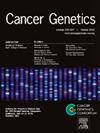Resolving HER2 status in breast carcinoma patients with complete deletion of CEP17 in fluorescence in-situ hybridization assays
IF 2.1
4区 医学
Q4 GENETICS & HEREDITY
引用次数: 0
Abstract
Objectives
To assess the clinicopathologic features of breast cancers with complete CEP17 deletion and determine if alternative testing can resolve their HER2 status.
Methods
Cases with complete CEP17 deletion were identified, relevant clinicopathologic information was obtained, and fluorescence in-situ hybridization (FISH) was rerun with an alternative chromosome 17 control gene (RAI1, 17p11.2). One case was also evaluated by cytogenomic SNP microarray (CMA).
Results
Nine breast carcinoma cases were identified and displayed average HER2 copy numbers ranging from 1.1 to 4.7 (Average: 3.1). HER2 immunohistochemistry (IHC) result was available on 8/9 cases with 2/8 (25 %) displaying no staining, 2/8 (25 %%) displaying 1+ staining and 4/8 (50 %) with 2+ staining. ER and PR IHC were available on 8/9 cases 7/8 (87.5 %) were ER and/or PR positive. RAI1 was present in all cases and, if used in place of CEP17, the ASCO/CAP group classification would have been 2/9 (22.2 %) Group 1, 2/9 (22.2 %) Group 4, and 5/9 (55.6 %) Group 5. CMA confirmed complete CEP17 deletion in one case.
Conclusions
Alternative chromosome 17 markers and/or CMA may be needed to resolve HER2 status in patients with complete deletion of CEP17.
荧光原位杂交法测定CEP17完全缺失乳腺癌患者的HER2状态
目的评估CEP17完全缺失乳腺癌的临床病理特征,并确定替代检测是否可以解决其HER2状态。方法筛选CEP17完全缺失的病例,获取相关临床病理信息,并与17号染色体的另一对照基因(RAI1, 17p11.2)进行原位荧光杂交(FISH)。用细胞基因组SNP微阵列(CMA)对1例进行了评估。结果9例乳腺癌患者的平均HER2拷贝数为1.1 ~ 4.7,平均值为3.1。8/9例有HER2免疫组化(IHC)结果,2/8(25%)未染色,2/8(25%)1+染色,4/8(50%)2+染色。7/8 (87.5%) ER和/或PR阳性。RAI1在所有病例中均存在,如果代替CEP17, ASCO/CAP组分类将为2/9(22.2%)组1、2/9(22.2%)组4和5/9(55.6%)组5。CMA证实1例CEP17完全缺失。结论替代17号染色体标记和/或CMA可能需要解决CEP17完全缺失患者的HER2状态。
本文章由计算机程序翻译,如有差异,请以英文原文为准。
求助全文
约1分钟内获得全文
求助全文
来源期刊

Cancer Genetics
ONCOLOGY-GENETICS & HEREDITY
CiteScore
3.20
自引率
5.30%
发文量
167
审稿时长
27 days
期刊介绍:
The aim of Cancer Genetics is to publish high quality scientific papers on the cellular, genetic and molecular aspects of cancer, including cancer predisposition and clinical diagnostic applications. Specific areas of interest include descriptions of new chromosomal, molecular or epigenetic alterations in benign and malignant diseases; novel laboratory approaches for identification and characterization of chromosomal rearrangements or genomic alterations in cancer cells; correlation of genetic changes with pathology and clinical presentation; and the molecular genetics of cancer predisposition. To reach a basic science and clinical multidisciplinary audience, we welcome original full-length articles, reviews, meeting summaries, brief reports, and letters to the editor.
 求助内容:
求助内容: 应助结果提醒方式:
应助结果提醒方式:


